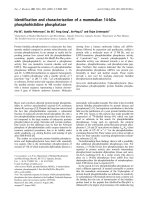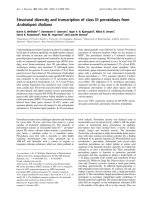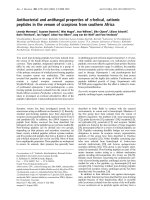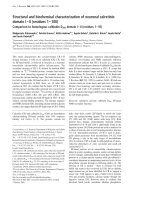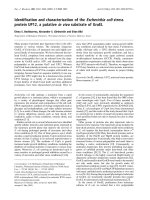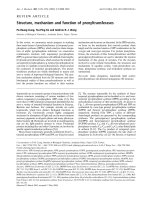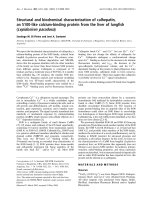Báo cáo y học: "Inflammation causes tissue-specific depletion of vitamin B6" pps
Bạn đang xem bản rút gọn của tài liệu. Xem và tải ngay bản đầy đủ của tài liệu tại đây (162.71 KB, 9 trang )
Open Access
Available online />R1254
Vol 7 No 6
Research article
Inflammation causes tissue-specific depletion of vitamin B
6
En-Pei Chiang
1
, Donald E Smith
2
, Jacob Selhub
3
, Gerard Dallal
4
, Yi-Cheng Wang
1
and
Ronenn Roubenoff
5
1
Department of Food Science and Biotechnology, National Chung Hsing University, Taichung, Taiwan
2
Comparative Biology Unit, Jean Mayer USDA Human Nutrition Research Center on Aging, Tufts University, Boston, MA, USA
3
Vitamin Metabolism and Aging Laboratory (JS), New England Medical Center, Boston, MA, USA
4
Biostatistics Unit (GD), New England Medical Center, Boston, MA, USA
5
Nutrition, Exercise Physiology, and Sarcopenia Laboratory, New England Medical Center, Boston, MA, USA
Corresponding author: En-Pei Chiang,
Received: 4 May 2005 Revisions requested: 4 Jul 2005 Revisions received: 2 Aug 2005 Accepted: 15 Aug 2005 Published: 13 Sep 2005
Arthritis Research & Therapy 2005, 7:R1254-R1262 (DOI 10.1186/ar1821)
This article is online at: />© 2005 Chiang et al.; licensee BioMed Central Ltd.
This is an Open Access article distributed under the terms of the Creative Commons Attribution License ( />2.0), which permits unrestricted use, distribution, and reproduction in any medium, provided the original work is properly cited.
Abstract
Previously we observed strong and consistent associations
between vitamin B
6
status and several indicators of inflammation
in patients with rheumatoid arthritis. Clinical indicators, including
the disability score, the length of morning stiffness, and the
degree of pain, and biochemical markers, including the
erythrocyte sedimentation rate and C-reactive protein levels,
were found to be inversely correlated with circulating vitamin B
6
levels. Such strong associations imply that impaired vitamin B
6
status in these patients results from inflammation. In the present
study we examined whether inflammation directly alters vitamin
B
6
tissue contents and its excretion in vivo. A cross-sectional
case-controlled human clinical trial was performed in parallel
with experiments in an animal model of inflammation. Plasma
and erythrocyte and pyridoxal 5'-phosphate concentrations,
urinary 4-pyridoxic acid excretion, and the activity coefficient of
erythrocyte aspartate aminotransferase were compared
between patients and healthy subjects. Adjuvant arthritis was
induced in rats for investigating hepatic and muscle contents as
well as the urinary excretion of vitamin B
6
during acute and
chronic inflammation. Patients with rheumatoid arthritis had low
plasma pyridoxal 5'-phosphate compared with healthy control
subjects, but normal erythrocyte pyridoxal 5'-phosphate and
urinary 4-pyridoxic acid excretion. Adjuvant arthritis in rats did
not affect 4-pyridoxic acid excretion or muscle storage of
pyridoxal 5'-phosphate, but it resulted in significantly lower
pyridoxal 5'-phosphate levels in circulation and in liver during
inflammation. Inflammation induced a tissue-specific depletion
of vitamin B
6
. The low plasma pyridoxal 5'-phosphate levels seen
in inflammation are unlikely to be due to insufficient intake or
excessive vitamin B
6
excretion. Possible causes of decreased
levels of vitamin B
6
are discussed.
Introduction
Vitamin B
6
deficiency results in adverse health consequences,
including hyperhomocysteinemia [1] and possibly arterioscle-
rotic lesions [2]. We have reported that the degree of disease
activity is associated with vitamin B
6
indices in patients with
rheumatoid arthritis [3,4]. Bates and colleagues reported sub-
optimal vitamin B
6
status in inflammatory conditions and in the
acute-phase response in the elderly population [5]. These
observations have attracted attention partly because vitamin
B
6
deficiency and several markers of inflammation were both
found to be independent risk factors for thrombosis [6,7].
Although several clinical trials and epidemiological studies
have demonstrated the associations between vitamin B
6
and
inflammatory diseases, the association between vitamin B
6
status and inflammatory markers has been contentious, and
the cause-effect relationship between these two has not been
elucidated.
Pyridoxine deficiency increased the degree of paw edema by
54% in a rat model of inflammation; it was therefore suggested
that pyridoxine deficiency might enhance inflammation [8].
However, in healthy middle-aged adults, B vitamin status does
not seem to be a strong correlate of circulating levels of inflam-
matory markers [9]. In contrast, a low level of circulating vita-
min B
6
was found to be associated with elevation of the
inflammatory marker C-reactive protein independently of
plasma homocysteine levels in the Framingham Heart Study
cohort [10]. A recent study indicated that low plasma concen-
trations of pyridoxal 5'-phosphate are inversely related to major
markers of inflammation and independently associated with
Arthritis Research & Therapy Vol 7 No 6 Chiang et al.
R1255
increased coronary artery disease in the Italian population
[11]. Decreased vitamin B
6
status was also reported in
patients after surgery and trauma [12]. In conditions with
inflammation such as inflammatory bowel disease, low plasma
levels of vitamin B
6
are commonly found, especially in patients
with active disease [13]. In a recent study we observed strong
and consistent associations between vitamin B
6
status and
several indicators of inflammation in patients with rheumatoid
arthritis [4]. Plasma pyridoxal 5'-phosphate was correlated
with disease-related disability, morning stiffness, and degree
of pain, C-reactive protein, serum albumin, and erythrocyte
sedimentation rate [4].
The objective of the present study was to determine whether
inflammation directly decreases the primary pools of vitamin
B
6
metabolism and storage, and to examine whether inflamma-
tion alters the excretion of vitamin B
6
in vivo.
Materials and methods
Clinical trial
Study subjects
Thirty-three adults (aged at least 18 years) with rheumatoid
arthritis were recruited from the Tufts University New England
Medical Center Arthritis Center, Boston, as described previ-
ously [14]. Seventeen healthy control subjects, who did not
differ in their age range or gender distribution from the sub-
jects with rheumatoid arthritis, were recruited through adver-
tisements in the greater Boston area. Study subjects were 18
to 80 years old. For the rheumatoid arthritis group, subjects
had to fulfill the American College of Rheumatology criteria for
rheumatoid arthritis [15]. The criteria for the classification of
acute arthritis of rheumatoid include the following: (1) morning
stiffness in and around the joints, lasting at least 1 hour before
maximal improvement; (2) at least three joint areas simultane-
ously have had soft tissue swelling or fluid (not bony over-
growth alone) observed by a physician; (3) at least one area
swollen of hand joints in a wrist, metacarpophalangeal, or prox-
imal interphalangeal joint; (4) simultaneous involvement of the
same joint areas (as defined in (2)) on both sides of the body;
(5) rheumatoid nodules observed by a physician; (6) abnormal
amounts of serum rheumatoid factor; (7) radiographic
changes typical of rheumatoid arthritis on posteroanterior
hand and wrist radiographs, which must include erosions or
unequivocal bony decalcification localized in or most marked
adjacent to the involved joints.
Written informed consent was obtained from all subjects in
accordance with the regulations of the New England Medical
Center/Tufts University Human Investigation Review Commit-
tee. Subjects with pregnancy, anemia (hemoglobin 10 mg/dL
or lower), thrombocytopenia (platelet count 50,000/ µL or
lower), abnormal serum hepatic transaminase (serum aspar-
tate aminotransferase or alanine aminotransferase at least 50
IU/L), renal insufficiency (serum creatinine at least 1.5 mg/dL),
diabetes, cancer or use of oral contraceptive were excluded.
Thirteen of the 33 patients (39%) and 7 of the 17 controls
(41%) were taking vitamin B6 or multivitamin supplements
before enrollment. These subjects were asked to stop doing
so for at least 2 months before their participation in the study.
Experimental protocol
This cross-sectional study was conducted in the New England
Medical Center General Clinical Research Center. Before
enrollment, each subject was examined by the study physician,
and was screened by blood and urine analyses to ensure eli-
gibility. Each subject was instructed to perform a 24-hour urine
collection for measurement of 4-pyridoxic acid excretion.
Patients taking methotrexate were asked to come in at least 24
hours after their weekly dose of the medicine to minimize any
potential acute effect on laboratory outcomes. Urine speci-
mens were kept at 4°C with no additive during the collection
period. After completion of the 24-hour urine collection, sub-
jects were asked to fast overnight for 12 hours. During the fol-
lowing morning, fasting blood was drawn into a tube
containing EDTA for the determination of plasma pyridoxal 5'-
phosphate, erythrocyte pyridoxal 5'-phosphate, erythrocyte
aspartate aminotransferase activity coefficient, folate, and vita-
min B
12
. Blood was also collected for hematology and chem-
istry analyses. Each patient's blood specimens were kept on
ice and were centrifuged within 15 min of the blood draw.
Animal model of inflammation
Animal
Thirty-six female 3-month-old Lewis rats were obtained from
the National Institutes of Health. Animals were fed with the
AIN93M diet during a 1-week washout period and during the
experimental period. All animals were kept in individual mesh
cages and acclimated to a 12-hour day/night cycle. The study
protocol was approved by the Animal Care and Use Commit-
tee of National Chung Hsing University and of the Human
Nutrition Research Center on Aging at Tufts University.
Induction of arthritis
After the washout period, animals of the same age and gender
were sorted by body weight and assigned sequentially to the
adjuvant arthritis or control groups (Table 1). Adjuvant arthritis
was induced at baseline by injecting a single dose of Myco-
bacterium butyricum in mineral oil (complete Freund's adju-
vant; 200 µL per rat) [16] into the base of the tail at the
baseline time-point. The age-matched, paired-fed control ani-
mals received a saline injection.
Pair-feeding protocol
After the induction of adjuvant arthritis, for each rat in the adju-
vant arthritis group one control rat, matched for age and
weight, received the same amount of food on the next day. This
protocol minimized variations in body weight and in vitamin B
6
consumption due to different dietary intake.
Available online />R1256
Sample collection
Fasting blood samples were collected from the orbital sinus
vein of each rat under anesthesia at baseline. Plasma was sep-
arated immediately by centrifugation and stored at -80°C until
analysis. Sixteen animals (eight control and eight arthritic rats)
were killed 21 days after the adjuvant injection, reflecting the
condition of acute inflammation. The rest were killed on day
42, reflecting the condition of chronic inflammation. Animals
were killed by thoracotomy and exsanguinations after anesthe-
sia. Blood, liver, and skeletal muscle were collected and stored
at -80°C until analysis for pyridoxal 5'-phosphate concentra-
tion. On selected days (days reflecting baseline, peak inflam-
mation, and chronic inflammation), each animal was kept in an
individual metabolic cage, specifically designed for the 24-
hour collection of urine. The excretion of urinary 4-pyridoxic
acid and creatinine was subsequently measured.
Laboratory analyses
Blood hematology and chemistry analyses and urinalysis for
human subjects were performed at the New England Medical
Center Clinical Laboratory, Boston. For measurements of B
vitamins, fasting blood was drawn from each human subject,
and plasma was separated and stored at -80°C until analysis.
Erythrocytes were washed three times with 0.9% saline and
then an aliquot of packed erythrocytes was frozen before the
measurement of erythrocyte aspartate aminotransferase [17].
The activity coefficient of erythrocyte aspartate aminotrans-
ferase was calculated by dividing pyridoxal 5'-phosphate-stim-
ulated enzyme activity by the unstimulated activity. For
pyridoxal 5'-phosphate analysis, the freshly washed erythro-
cytes were extracted with an equal volume of 10% (w/v) per-
chloroacetic acid. After centrifugation, the supernatants were
stored at -70°C until analysis. Erythrocyte and plasma pyri-
doxal 5'-phosphate concentrations were assayed by a modifi-
cation of the tyrosine decarboxylase enzymatic procedure of
Camp and colleagues [18], in which a 20 µL aliquot of sample
was precipitated with 80 µL of 5% (w/v) trichloroacetic acid
for deproteinization. The erythrocyte pyridoxal 5'-phosphate
results were expressed as nmol/L of packed erythrocytes at a
hematocrit of 100%. The coefficient of variation (percentage
of the mean) for the pyridoxal 5'-phosphate assay was 7.6%
within assays and 5.7% between assays. Plasma folate, red
blood cell folate, and plasma vitamin B
12
were measured with
Quantaphase II B
12
/Folate Radioassays (Bio-Rad; Hercules,
CA). The weight of each 24-hour urine specimen was meas-
ured; aliquots were taken and stored at -20°C until analysis.
No preservatives were added to the 4-pyridoxic acid or creat-
inine aliquots. 4-Pyridoxic acid was measured by high-per-
formance liquid chromatography after urine had been mixed
with an equal volume of 5% trichloroacetic acid for deprotein-
ization [19]. The HPLC consisted of a Hitachi L-7100 intelli-
gent pump connected to an L-2480 fluorometric detector. The
ranges for plasma pyridoxal 5'-phosphate and urinary pyridoxic
acid were in good agreement with published results. The
range of erythrocyte pyridoxal 5'-phosphate concentrations in
our subjects was similar to that in a previous study by
Heiskanen and colleagues [20].
Statistical analysis
Data were plotted so that they could be examined for normality
before statistical analyses. Data for plasma pyridoxal 5'-phos-
phate and red blood cell folate levels in humans were log-
transformed to achieve normal distributions, and the geomet-
ric means with the antilogarithm of the 95% confidence inter-
vals are presented as results. Student's t-tests for
independent samples were performed to determine whether
there was a difference between patients with rheumatoid
arthritis and controls in hematology measures, blood chemistry
analyses, and vitamin profiles. For animal experiments, pooled
Student's t-tests were performed to determine whether there
was a difference between arthritic rats and matched control
animals. All statistical analyses were performed with Systat 9.0
for Windows™ (SPSS, Chicago, IL).
Results
Demographic information
Thirty-six patients with rheumatoid arthritis were recruited from
a previous study [14]. In the present study, a further 17 healthy
subjects were recruited as control subjects. Three subjects
from the patient group dropped out because of inconvenience
of the 24-hour urine collection. Clinical and demographic char-
acteristics of the study subjects are shown in Table 2. There
were no differences in age, height, or weight between patients
and controls, indicating that the control subjects and the
patients did not differ in their physical conditions except for the
presence of rheumatoid arthritis. The average disease duration
in patients with rheumatoid arthritis was 10.8 ± 6.7 (mean ±
SD) years. While participating in the study, 21 patients were
Table 1
Changes in body weight in response to adjuvant arthritis in Lewis rats
Group Body weight (g)
Baseline Day 21 Day 42
Adjuvant arthritis 275.4 ± 85.3 228.9 ± 71.4 (-16.9%) 214.1 ± 60.7 (-22.3%)
Control 268.3 ± 86.3 259.1 ± 77.5 (-3.4%) 262.1 ± 73.0 (-2.3%)
Data are shown as means ± SD. Percentage changes in body weight at each time point (compared with baseline) are shown in parentheses. Day
21 represents the acute inflammation condition; day 42 represents the chronic inflammation condition.
Arthritis Research & Therapy Vol 7 No 6 Chiang et al.
R1257
taking non-steroidal anti-inflammatory drugs, 18 were taking
prednisone, 16 were taking methotrexate, and 5 were taking
gold. All patients had been taking the same medications for
the 2 months preceding their entry into the study.
Patients and controls did not differ in the levels of serum albu-
min, creatinine, aspartate aminotransferase, and alanine ami-
notransferase. Patients had higher serum alkaline
phosphatase levels, white blood cell counts and erythrocyte
sedimentation rates than controls; patients also had a trend
toward a reduced hematocrit, a smaller number of red blood
cells and a lower hemoglobin level than the healthy control
subjects (Table 2). Serum alkaline phosphatase concentration
was inversely correlated with plasma pyridoxal 5'-phosphate
concentration in all subjects (Pearson's correlation, r = -0.35,
P = 0.012). In addition, serum albumin was modestly corre-
lated with plasma pyridoxal 5'-phosphate in the patients (Pear-
son's correlation, r = 0.37, P = 0.04) but not in the control
subjects.
Vitamin B
6
indices were altered in specific tissues during
inflammation in humans with rheumatoid arthritis
In the human study, plasma pyridoxal 5'-phosphate concentra-
tions were significantly lower in patients than in healthy sub-
jects (with about 50% lower). This observation was
comparable to our previous finding [3]. In contrast, no differ-
ence was found between patients and controls in erythrocyte
pyridoxal 5'-phosphate or erythrocyte aspartate aminotrans-
ferase or 4-pyridoxic acid levels. No difference was found in
concentrations of plasma folate, red blood cell folate or plasma
vitamin B
12
between patients and controls.
These results suggest that the lower vitamin B
6
concentration
in patients with rheumatoid arthritis is tissue-specific.
Induction and progression of adjuvant arthritis in
animals
Adjuvant arthritis was induced as described in the Materials
and methods section. Arthritis onset was on day 14; the rats
injected with adjuvant showed arthritic reactions including
swollen paws and hind legs. Inflammation reached its peak on
day 21 after the adjuvant injection. Joint swelling and body
weight reduction continued for a further 4 weeks after the
onset of arthritis (Table 1). Animals in the control and adjuvant
groups were well matched in body weight at baseline before
the induction of adjuvant arthritis.
Table 2
Characteristics of study subjects
Characteristic RA (n = 33) Controls (n = 17) P
Sex (F:M) 23:10 10:7 -
Age 53.5 ± 12.4 52.9 ± 15.7 NS
Height (cm) 167.3 ± 11.0 170.1 ± 8.6 NS
Weight (kg) 77.1 ± 21.1 74.9 ± 17.9 NS
Rheumatoid factor (IU/mL) 89.4 ± 76.1 < 20 <0.0001
Chemistry
Urinary creatinine (g/24 h) 1.0 ± 0.4 1.2 ± 0.3 NS
Serum urea nitrogen (mg/dL) 13.2 ± 4.3 15.6 ± 3.0 <0.05
Albumin (g/dL) 3.9 ± 0.4 4.0 ± 0.4 NS
Serum AST (IU/L) 19.4 ± 9.8 21.9 ± 11.2 NS
Serum ALT (IU/L) 21.4 ± 4.5 23.9 ± 7.5 NS
Alkaline phosphatase (IU/L) 72.2 ± 19.6 57.2 ± 14.3 <0.01
Hematology
White blood cell counts (/nL) 7.3 ± 3.0 5.5 ± 1.2 <0.01
Hematocrit (%) 38.0 ± 3.5 39.8 ± 3.1 0.06
Hemoglobin (g/dL) 13.0 ± 1.6 13.7 ± 1.2 0.08
Mean corpuscular volume (fL) 88.3 ± 4.1 87.6 ± 6.4 NS
ESR (mm/h) 30.8 ± 20.4 8.2 ± 2.8 <0.0001
Data are presented as means ± SD. AST, aspartate aminotransferase; ALT, alanine aminotransferase; ESR, erythrocyte sedimentation rate; RA,
rheumatoid arthritis. Bold P values are statistically significant.
Available online />R1258
Adjuvant arthritis altered vitamin B
6
contents in specific
tissues in the Lewis rat model
At baseline before the adjuvant/saline injection, there was no
difference between the adjuvant arthritis group and the saline-
injected group in plasma concentrations of pyridoxal 5'-phos-
phate or urinary 4-pyridoxic acid excretion. These observations
indicated that the animals were also well matched at baseline
with regard to their vitamin B
6
status. From then on, each con-
trol animal received the same amount of food as its experimen-
tal counterpart ingested during the previous 24 hours; this
pair-feeding procedure minimized the impact of various vitamin
intakes between the adjuvant-treated and the control animals.
Adjuvant arthritis reached its peak 21 days after the injection.
At peak inflammation, significantly lower levels of pyridoxal 5'-
phosphate were found in the circulation and in liver in those
arthritis rats, but muscle pyridoxal 5'-phosphate concentration
seemed to be unaltered. A lower level of pyridoxal 5'-phos-
phate was also present in the circulation and in liver during
chronic inflammation on day 42. However, prolonged inflam-
mation did not alter the muscle content of pyridoxal 5'-phos-
phate. Plasma pyridoxal 5'-phosphate concentration was
correlated with hepatic pyridoxal 5'-phosphate content during
peak (Pearson's correlation, r = 0.51, P < 0.005) and chronic
(r = 0.38, P < 0.04) inflammation.
Adjuvant arthritis does not increase the urinary excretion
of vitamin B
6
at peak inflammation or during the chronic
phase of inflammation
Despite the significantly lower pyridoxal 5'-phosphate levels in
plasma and liver at acute inflammation, we did not observe a
significant change in urinary 4-pyridoxic acid or creatinine
excretion, indicating that the low level of vitamin B
6
in plasma
or liver at acute inflammation was not caused by excessive
excretion of this vitamin. The 24-hour urinary excretion of 4-
pyridoxic acid was highly correlated with the 24-hour urinary
creatinine excretion throughout the study, indicating that renal
function could be a significant determinant of 4-pyridoxic acid
excretion in these animals. At baseline, 24-hour urinary 4-pyri-
doxic acid excretion was highly correlated with 24-hour urinary
creatinine excretion in all rats (Pearson's correlation, r = 0.85,
P < 0.0001). The 24-hour urinary excretion of 4-pyridoxic acid
was correlated with 24-hour urinary creatinine excretion on
day 21 (in control animals, r = 0.615, P = 0.005; in arthritic
animals, r = 0.617, P = 0.014) and on day 42 (in control ani-
mals, r = 0.78, P < 0.0001; in arthritic animals, r = 0.80, P <
0.0001).
Discussion
The results of these rat and human studies indicate that inflam-
mation directly affects vitamin B
6
metabolism differently in dif-
ferent tissues. Furthermore, the low vitamin B
6
level is unlikely
to be due to a decrease in food intake or the excessive excre-
tion of vitamin B
6
. Adjuvant arthritis in Lewis rats is a useful ani-
mal model for studying vitamin B
6
status during inflammation.
Adjuvant arthritis decreased the pyridoxal 5'-phosphate pools
in the circulation and liver, whereas it did not alter the pyridoxal
5'-phosphate pool in the skeletal muscle. Liver was studied
because of its significant metabolic relevance and muscle was
studied because it is the major store for vitamin B
6
. The lower
plasma pyridoxal 5'-phosphate concentration in arthritic ani-
mals during inflammation was found to be in the physiological
range seen in humans with rheumatoid arthritis. Despite the
limited number of human subjects, the difference between
patients and controls in plasma pyridoxal 5'-phosphate con-
centration was significant. The average plasma pyridoxal 5'-
phosphate concentration in patients with rheumatoid arthritis
was about 55% of the level seen in the healthy controls. The
mean pyridoxal 5'-phosphate concentration in rats with adju-
vant arthritis was about 53% of the controls at peak inflamma-
tion on day 21. Rat adjuvant arthritis reflected the altered
plasma pyridoxal 5'-phosphate and it is a potential model for
studying vitamin B
6
status during inflammation.
Lumeng and colleagues suggested that plasma pyridoxal 5'-
phosphate concentration reflects vitamin B
6
status in the liver
in healthy humans [21]. Kinetic studies in rats also indicate
that changes in plasma pyridoxal 5'-phosphate content prima-
rily reflect changes in the relatively small, but metabolically rel-
evant and more rapidly exchanging, liver pool (as compared
with muscle) [22]. However it was not clear whether this is
true during inflammation. The reduced plasma pyridoxal 5'-
phosphate level in our study implies that vitamin B
6
status in
the liver in these patients was altered, because we previously
found good correlations between circulating pyridoxal 5'-
phosphate level and vitamin B
6
functional status measured by
methionine load and tryptophan load in these patients [14].
Results from adjuvant arthritis were in agreement with this
postulation. In the rat arthritis model, both plasma and hepatic
pyridoxal 5'-phosphate concentrations were lower (Table 3).
Furthermore, plasma pyridoxal 5'-phosphate concentration
was correlated with hepatic pyridoxal 5'-phosphate content.
These results suggest that the lower circulating pyridoxal 5'-
phosphate levels observed in rheumatoid arthritis could reflect
a decrease in hepatic pyridoxal 5'-phosphate pools, and
plasma pyridoxal 5'-phosphate is a good indicator of liver B
6
status during inflammation.
Our data imply that there are distinct metabolic roles for
plasma and erythrocytes in vitamin B
6
metabolism during
inflammation, and that the impact of inflammation on vitamin B
6
is tissue specific. In human subjects, despite the significantly
lower pyridoxal 5'-phosphate in plasma (and possibly in liver),
erythrocyte pyridoxal 5'-phosphate seemed to be adequate in
patients with rheumatoid arthritis, because no difference was
found between patients and healthy controls in the erythrocyte
pyridoxal 5'-phosphate level or the activity coefficient of eryth-
rocyte aspartate aminotransferase (Table 4). These observa-
tions are in agreement with the findings by Talwar and
colleagues, which showed that pyridoxal 5'-phosphate
Arthritis Research & Therapy Vol 7 No 6 Chiang et al.
R1259
decreases in plasma but not erythrocytes during systemic
inflammatory response [23].
Data from our animal model imply localized vitamin B
6
deple-
tion during inflammation. Before the present study it was not
clear how the pyridoxal 5'-phosphate pool in muscle might
react to an inflammatory process. In rats with adjuvant arthritis,
hepatic pyridoxal 5'-phosphate content was decreased,
whereas muscle pyridoxal 5'-phosphate content remained
unaltered, suggesting localized vitamin B
6
deficiency during
inflammation.
Skeletal muscle seems to be less sensitive to vitamin B
6
defi-
ciency in humans. In young healthy males receiving a defined
diet restricted in vitamin B
6
, the muscle content of vitamin B
6
is relatively resistant to vitamin B
6
deficiency, whereas plasma
pyridoxal 5'-phosphate is more sensitive to dietary vitamin B
6
depletion [24]. We conclude that liver and muscle have dis-
tinctive roles as the body undergoes metabolic changes; skel-
etal muscle, the body's major storage site of vitamin B
6
, may
turn over very slowly during inflammation.
Low vitamin B
6
status is unlikely to be due to lower
intake or excessive excretion
Dietary intake is known to be a major determinant of vitamin B
6
status. The arthritic and control rats showed decreases in
plasma pyridoxal 5'-phosphate from the baseline levels. This
was partly due to a decrease in overall food intake in both
groups. However, the different vitamin B
6
status observed
between animals with adjuvant arthritis and control animals in
the present study was not caused by different food intake
between the two groups. Food intake of individual rats in the
Table 3
Effects of adjuvant arthritis on B vitamin status during inflammation in rats
Component Adjuvant arthritis (n = 18) Control (n = 20) P
Baseline
Plasma pyridoxal 5'-phosphate (nmol/L) 793.9 ± 191.3 744.2 ± 145.4 0.89
Urinary 4-pyridoxic acid (µg/d) 30.8 ± 17.3 30.0 ± 18.9 0.89
Acute inflammation
Plasma pyridoxal 5'-phosphate (nmol/L) 252.0 ± 62.5 480.9 ± 144.0 <0.0001
Urinary 4-pyridoxic acid (µg/24 h) 27.7 ± 14.9 32.9 ± 17.2 0.249
Liver pyridoxal 5'-phosphate (nmol/g) 22.6 ± 1.7 27.4 ± 4.9 0.035
Skeletal muscle pyridoxal 5'-phosphate (nmol/g) 7.7 ± 1.8 7.2 ± 0.9 0.88
Chronic inflammation
Plasma pyridoxal 5'-phosphate (nmol/L) 324.2 ± 91.6 393.7 ± 143.5 0.033
Urinary 4-pyridoxic acid (µg/24 h) 31.1 ± 11.8 27.1 ± 14.2 0.39
Liver pyridoxal 5'-phosphate (nmol/g) 21.1 ± 3.0 31.7 ± 4.7 0.0001
Muscle pyridoxal 5'-phosphate (nmol/g) 8.7 ± 4.8 6.4 ± 2.5 0.907
Data are presented as means ± SD. Day 21 represents the acute inflammation condition; day 42 represents the chronic inflammation condition.
Bold P values are statistically significant.
Table 4
Indices of vitamin B status in patients with rheumatoid arthritis and control subjects
Component Patients (n = 33) Controls (n = 17) P
Plasma pyridoxal 5'-phosphate (nmol/L)
a
24.7 (19.5–31.1) 46.2 (35.3–60.3) 0.001
Red blood cell pyridoxal 5'-phosphate (nmol/L packed red blood cells) 39.7 (34.2–45.2) 33.1 (24.4–41.7) 0.182
α
EAST
1.8 (1.8–1.9) 1.9 (1.8–2.1) 0.242
Urinary 4-pyridoxic acid (µg/day)
a
0.8 (0.6–1.0) 1.1 (0.9–1.6) 0.08
Plasma folate (µg/L)
a
10.2 (8.4–12.5) 9.5 (7.9–11.3) 0.185
Red blood cell folate (µg/L)
a
302 (262–347) 274 (226–333) 0.404
Vitamin B
12
(ng/L)
a
434 (390–496) 398 (334–473) 0.371
Data are shown as geometric means and 95% confidence intervals.
a
Data were log-transformed to achieve normality for statistical analysis. α
EAST
,
erythrocyte aspartate aminotransferase activity coefficient. Bold P values are statistically significant.
Available online />R1260
arthritis group was recorded daily, then a one-to-one match
(each rat with adjuvant arthritis had its own weight-matched,
saline-injected control) in food intake was arranged. This pair-
feeding regimen in our animal experiments minimized the con-
founding effects of anorexia on the measures of vitamin B
6
.
Despite the significantly lower plasma pyridoxal 5'-phosphate
in patients, 24-hour urinary 4-pyridoxic acid excretion in
patients with rheumatoid arthritis did not differ from that of the
healthy control subjects (Table 4). The low circulating pyri-
doxal 5'-phosphate level seen in these patients therefore did
not result from excessive catabolism of vitamin B
6
. This is in
agreement with the observation in our animal model. The 24-
hour urinary excretion of 4-pyridoxic acid did not differ
between control and rats with adjuvant arthritis, despite lower
pyridoxal 5'-phosphate levels in plasma and liver in the adju-
vant arthritic rats. To summarize these observations, the abnor-
mal vitamin B
6
status in rheumatoid arthritis results from the
inflammatory process, and it is unlikely that it resulted from
insufficient intake or excessive excretion of vitamin B
6
.
Potential factors involved in the compartmentalization
of pyridoxal 5'-phosphate during inflammation
In healthy populations, the variance in plasma pyridoxal 5'-
phosphate can be explained to a great extent by vitamin intake,
serum albumin, and alkaline phosphatase. The later two are
physiological variables directly related to pyridoxal 5'-phos-
phate metabolism. In an elderly Dutch population it was
reported that a combination of vitamin B
6
intake, alkaline phos-
phatase, alcohol consumption, and albumin accounted for 30
to 40% variance in plasma pyridoxal 5'-phosphate [25]. Serum
albumin is an acute-phase reactant that decreases during the
flaring of active arthritis [26]. As the major protein for pyridoxal
5'-phosphate transport in the circulation, albumin might pro-
tect pyridoxal 5'-phosphate from hydrolysis [27]. In the present
study, serum albumin was found to be correlated with plasma
pyridoxal 5'-phosphate in patients whereas no such correla-
tion was detected in the control subjects. Lower albumin levels
in patients with more active arthritis may partly contribute to
the lower pyridoxal 5'-phosphate level in these patients,
although further study is needed for this postulation.
Many patients with arthritis have been reported to have ele-
vated alkaline phosphatase [28], including those in the
present study. Although still in the normal range, mean serum
alkaline phosphatase levels in our patients were 26% elevated
compared with healthy control subjects. Alkaline phosphatase
hydrolyzes the phosphorylated form of vitamin B
6
[29]; we
therefore speculate that serum alkaline phosphatase could be
another key determinant of the concentration of circulating
vitamin B
6
coenzyme during inflammation. Alkaline phos-
phatase has been shown to regulate extracellular levels of pyri-
doxal 5'-phosphate in humans [30,31], and abnormal vitamin
B
6
metabolism was found in alkaline phosphatase knock-out
mice [32]. We found that the serum alkaline phosphatase level
was inversely correlated with the plasma pyridoxal 5'-phos-
phate level in our subjects, which indirectly supports the above
hypothesis. Compartmentalization of pyridoxal 5'-phosphate
has been reported in the acute-phase response, such as the
acute phase of myocardial infarction [33]. Because erythro-
cyte pyridoxal 5'-phosphate level seem to be normal whereas
plasma and hepatic pyridoxal 5'-phosphate levels are signifi-
cantly lower during inflammation, pyridoxal 5'-phosphate might
be compartmentalized between tissues. The elevated alkaline
phosphatase during inflammation may facilitate the mobiliza-
tion and uptake of B
6
vitamers, because vitamin B
6
is taken up
by tissues primarily in the form of pyridoxal.
In contrast, elevated serum alkaline phosphatase or reduced
albumin did not provide a satisfactory explanation for the lower
plasma pyridoxal 5'-phosphate level in rheumatoid arthritis,
because the presence of disease remained a significant deter-
minant of plasma pyridoxal 5'-phosphate concentrations after
adjustment for serum alkaline phosphatase and albumin con-
centrations [34]. The low plasma pyridoxal 5'-phosphate level
in patients with rheumatoid arthritis may also be attributed to
elevated pyridoxal phosphatase activity during inflammation. It
has been reported that the decrease in plasma pyridoxal 5'-
phosphate characteristically seen in cirrhosis may be related
to a substantial elevation of hepatic pyridoxal 5'-phosphate
phosphatase activity [35]. McCarty hypothesized that the pro-
inflammatory cytokine interleukin-6 might stimulate the activity
of pyridoxal phosphatase in hepatocytes, in these patients,
and the elevated enzyme may result in reduced plasma pyri-
doxal 5'-phosphate concentrations [36].
It remains uncertain whether the activity of pyridoxal 5'-phos-
phate phosphatase is altered in patients with arthritis, and this
should be considered for future studies.
Conclusion
A lower pyridoxal 5'-phosphate concentration in the circulation
may reflect the removal of vitamin B
6
coenzymes from the cir-
culation to meet the higher demands of certain tissues during
inflammation. In the animal model of adjuvant arthritis, lower
pyridoxal 5'-phosphate levels in liver implied that it was largely
hepatic pyridoxal 5'-phosphate that was used during inflamma-
tion. Further studies investigating the kinetics and regulation of
B
6
vitamers and enzymes in different body compartments are
merited.
Competing interests
The author(s) declare that they have no competing interests.
Authors' contributions
All authors made substantive intellectual contributions to the
present study. EPC conceived of the study, acquired partial
funding, performed the human and animal experiments –
including study designs, coordination, biochemical analyses,
data acquisition, analysis, and interpretation – and drafted the
Arthritis Research & Therapy Vol 7 No 6 Chiang et al.
R1261
manuscript. DES participated in the design and procedures of
animal experiments. JS participated in the design of the study
and the acquisition of funding, and was involved in revising the
manuscript critically for important intellectual content. GED
participated in the design of the study and performed the sta-
tistical analysis. YCW performed the animal experiments and
analyses of metabolites. RR conceived of the study, acquired
funding, and performed all clinical assessments in study sub-
jects, and revised the manuscript critically for important intel-
lectual content. All authors read and approved the final
manuscript.
Acknowledgements
The authors thank Bernadette Muldoon RN, Karin Kohin RD, and Sarah
Olson RD for their assistance in recruiting, and thank Dr Pamela Bagley
for general support and supervision. Thanks are also given to Marie
Nadeau for technical assistance, and the staff at the Human Nutrition
Research Center Nutrition Evaluation Laboratory and the Tufts New
England Medical Center Clinical Laboratory for hematology and chem-
istry analyses; to the General Clinical Research Center nursing staff for
assistance with the study procedures; and to our volunteers. This
project has been supported in part by a grant from the National Science
Council of Taiwan (Grant # NSC 94-2320-B005-009; to E-PC). E-PC
is a recipient of Dissertation Award from the Arthritis Foundation in the
US. This project was also supported by the US Department of Agricul-
ture under cooperative agreement no. 58-1950-9-001. Any opinions,
findings, conclusions, or recommendations expressed in this publication
are those of the authors and do not necessarily reflect the view of the
US Department of Agriculture. This study was also supported in part by
grant RR-00054 from the National Center for Research Resources, for
the General Clinical Research Center, New England Medical Center
and Tufts University School of Medicine (to RR).
References
1. Mason JB, Miller JW: The effects of vitamins B12, B6, and folate
on blood homocysteine levels. Ann N Y Acad Sci 1992,
669:197-203.
2. Rinehart JF, Greenberg LD: Vitamin B6 deficiency in the rhesus
monkey; with particular reference to the occurrence of athero-
sclerosis, dental caries, and hepatic cirrhosis. Am J Clin Nutr
1956, 4:318-325.
3. Roubenoff R, Roubenoff RA, Selhub J, Nadeau MR, Cannon JG,
Freeman LM, Dinarello CA, Rosenberg IH: Abnormal vitamin B6
status in rheumatoid cachexia. Association with spontaneous
tumor necrosis factor alpha production and markers of
inflammation. Arthritis Rheum 1995, 38:105-109.
4. Chiang EP, Bagley PJ, Selhub J, Nadeau M, Roubenoff R: Abnor-
mal vitamin B
6
status is associated with severity of symptoms
in patients with rheumatoid arthritis. Am J Med 2003,
114:283-287.
5. Bates CJ, Pentieva KD, Prentice A, Mansoor MA, Finch S: Plasma
pyridoxal phosphate and pyridoxic acid and their relationship
to plasma homocysteine in a representative sample of British
men and women aged 65 years and over. Br J Nutr 1999,
81:191-201.
6. Cattaneo M: Hyperhomocysteinemia: a risk factor for arterial
and venous thrombotic disease. Int J Clin Lab Res 1997,
27:139-144.
7. Ridker PM, Hennekens CH, Buring JE, Rifai N: C-reactive protein
and other markers of inflammation in the prediction of cardio-
vascular disease in women. N Engl J Med 2000, 342:836-843.
8. Lakshmi R, Lakshmi AV, Divan PV, Bamji MS: Effect of riboflavin
or pyridoxine deficiency on inflammatory response. Indian J
Biochem Biophys 1991, 28:481-484.
9. Folsom AR, Desvarieux M, Nieto FJ, Boland LL, Ballantyne CM,
Chambless LE: B vitamin status and inflammatory markers.
Atherosclerosis 2003, 169:169-174.
10. Friso S, Jacques PF, Wilson PW, Rosenberg IH, Selhub J: Low cir-
culating vitamin B
6
is associated with elevation of the inflam-
mation marker C-reactive protein independently of plasma
homocysteine levels. Circulation 2001, 103:2788-2791.
11. Friso S, Girelli D, Martinelli N, Olivieri O, Lotto V, Bozzini C, Pizzolo
F, Faccini G, Beltrame F, Corrocher R: Low plasma vitamin B-6
concentrations and modulation of coronary artery disease risk.
Am J Clin Nutr 2004, 79:992-998.
12. Labadarios D, Brink PA, Weich HF, Visser L, Louw ME, Shephard
GS, van Stuijvenberg ME: Plasma vitamin A, E, C and B6 levels
in myocardial infarction. S Afr Med J 1987, 71:561-563.
13. Saibeni S, Cattaneo M, Vecchi M, Zighetti ML, Lecchi A, Lombardi
R, Meucci G, Spina L, de Franchis R: Low vitamin B
6
plasma lev-
els, a risk factor for thrombosis, in inflammatory bowel dis-
ease: role of inflammation and correlation with acute phase
reactants. Am J Gastroenterol 2003, 98:112-117.
14. Chiang EP, Bagley PJ, Roubenoff R, Nadeau M, Selhub J: Plasma
pyridoxal 5'-phosphate concentration is correlated with func-
tional vitamin B-6 indices in patients with rheumatoid arthritis
and marginal vitamin B-6 status. J Nutr 2003, 133:1056-1059.
15. Hochberg MC, Chang RW, Dwosh I, Lindsey S, Pincus T, Wolfe
F: The American College of Rheumatology 1991 revised crite-
ria for the classification of global functional status in rheuma-
toid arthritis. Arthritis Rheum 1992, 35:498-502.
16. Paulini K, Korner B, Mohr W, Sonntag W: The effect of complete
Freund-adjuvant on chronic proliferating inflammation in an
experimental granuloma model. Z Rheumatol 1976,
35:123-131.
17. Williams DG: Methods for the estimation of three vitamin
dependent red cell enzymes. Clin Biochem 1976, 9:252-255.
18. Camp VM, Chipponi J, Faraj BA: Radioenzymatic assay for direct
measurement of plasma pyridoxal 5'-phosphate. Clin Chem
1983, 29:642-644.
19. Gregory JF 3rd, Kirk JR: Determination of urinary 4-pyridoxic
acid using high performance liquid chromatography. Am J
Clin Nutr 1979, 32:879-883.
20. Heiskanen K, Siimes MA, Perheentupa J, Salmenpera L: Refer-
ence ranges for erythrocyte pyridoxal 5'-phosphate concentra-
tion and the erythrocyte aspartate transaminase stimulation
test in lactating mothers and their infants. Am J Clin Nutr 1994,
59:1297-1303.
21. Lumeng L, Lui A, Li TK: Plasma content of B6 vitamers and its
relationship to hepatic vitamin B6 metabolism. J Clin Invest
1980, 66:688-695.
22. Bode W, Mocking JA, van den Berg H: Influence of age and sex
on vitamin B-6 vitamer distribution and on vitamin B-6 metab-
olizing enzymes in Wistar rats. J Nutr 1991, 121:318-329.
23. Talwar D, Quasim T, McMillan DC, Kinsella J, Williamson C,
O'Reilly DS: Pyridoxal phosphate decreases in plasma but not
erythrocytes during systemic inflammatory response. Clin
Chem 2003, 49:515-518.
24. Coburn SP, Ziegler PJ, Costill DL, Mahuren JD, Fink WJ, Schalten-
brand WE, Pauly TA, Pearson DR, Conn PS, Guilarte TR:
Response of vitamin B-6 content of muscle to changes in vita-
min B-6 intake in men. Am J Clin Nutr 1991, 53:1436-1442.
25. Brussaard JH, Lowik MR, van den BH, Brants HA, Bemelmans W:
Dietary and other determinants of vitamin B6 parameters. Eur
J Clin Nutr 1997, 51(Suppl 3):S39-S45.
26. Denko CW, Gabriel P: Serum proteins – transferrin, ceruloplas-
min, albumin, alpha 1-acid glycoprotein, alpha 1-antitrypsin –
in rheumatic disorders. J Rheumatol 1979, 6:664-672.
27. Lumeng L, Brashear RE, Li TK: Pyridoxal 5'-phosphate in
plasma: source, protein-binding, and cellular transport. J Lab
Clin Med 1974, 84:334-343.
28. Aida S: Alkaline phosphatase isoenzyme activities in rheuma-
toid arthritis: hepatobiliary enzyme dissociation and relation to
disease activity. Ann Rheum Dis 1993, 52:511-516.
29. Lumeng L, Li TK: Characterization of the pyridoxal 5'-phos-
phate and pyridoxamine 5'-phosphate hydrolase activity in rat
liver. Identity with alkaline phosphatase. J Biol Chem 1975,
250:8126-8131.
30. Whyte MP, Mahuren JD, Vrabel LA, Coburn SP: Markedly
increased circulating pyridoxal-5'-phosphate levels in hypo-
phosphatasia. Alkaline phosphatase acts in vitamin B6
metabolism. J Clin Invest 1985, 76:752-756.
Available online />R1262
31. Anderson BB, O'Brien H, Griffin GE, Mollin DL: Hydrolysis of
pyridoxal-5'-phosphate in plasma in conditions with raised
alkaline phosphate. Gut 1980, 21:192-194.
32. Narisawa S, Wennberg C, Millan JL: Abnormal vitamin B6
metabolism in alkaline phosphatase knock-out mice causes
multiple abnormalities, but not the impaired bone
mineralization. J Pathol 2001, 193:125-133.
33. Vermaak WJ, Barnard HC, Van Dalen EM, Potgieter GM, Van
Jaarsveld H, Myburgh SJ: Compartmentalization of pyridoxal-5'-
phosphate during the acute phase of myocardial infarction.
Klin Wochenschr 1988, 66:428-433.
34. Chiang EP: Vitamin B6 and homocysteine metabolism in rheu-
matoid arthritis. In PhD thesis Tufts University, Nutritional Sci-
ence Department; 2000.
35. Merrill AH Jr, Henderson JM, Wang E, Codner MA, Hollins B, Mil-
likan WJ: Activities of the hepatic enzymes of vitamin B6
metabolism for patients with cirrhosis. Am J Clin Nutr 1986,
44:461-467.
36. McCarty MF: Increased homocyst(e)ine associated with smok-
ing, chronic inflammation, and aging may reflect acute-phase
induction of pyridoxal phosphatase activity. Med Hypotheses
2000, 55:289-293.

